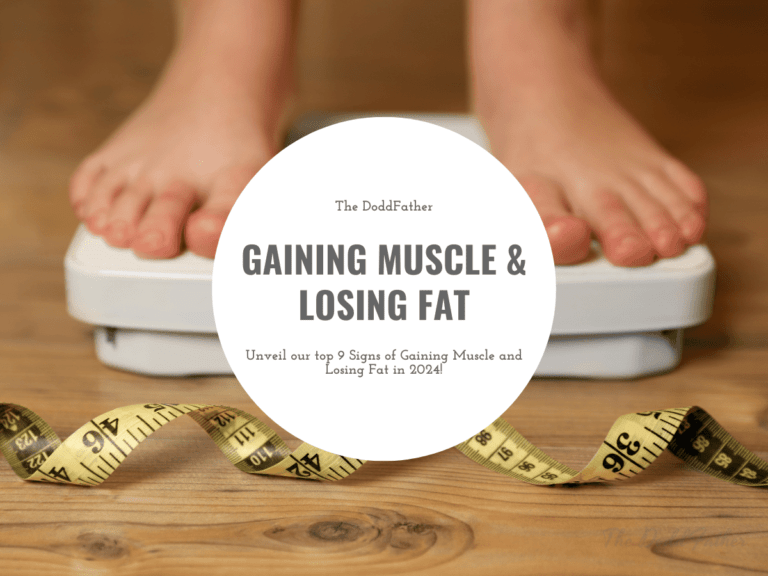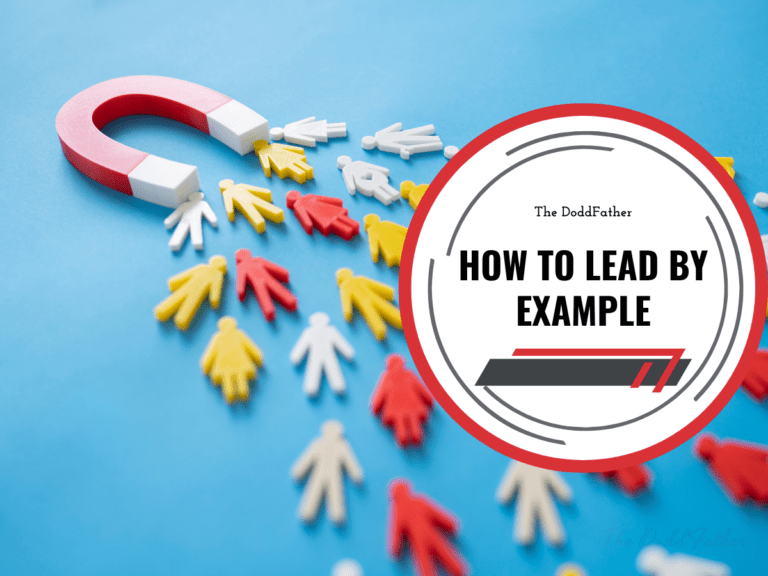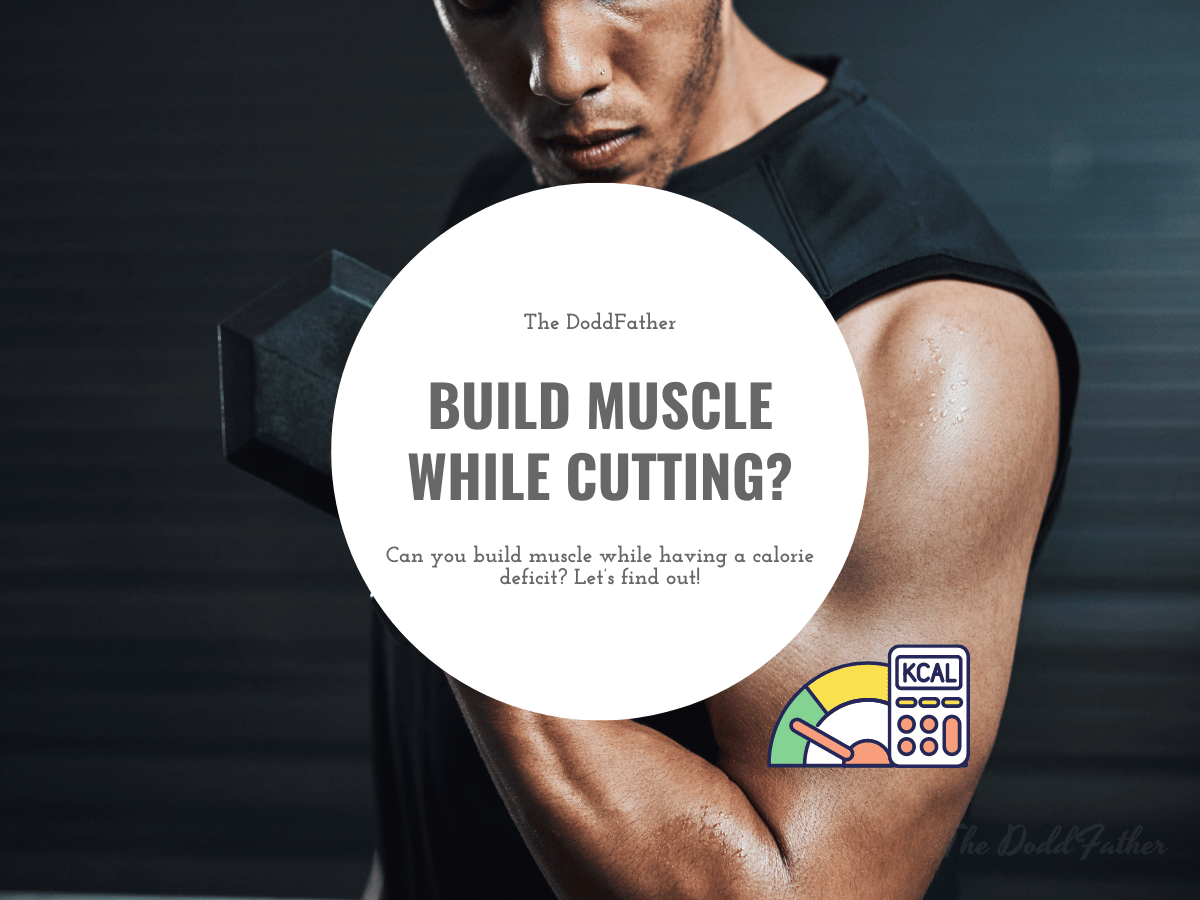
Cody Dodd is a NASM-certified personal trainer and Navy Command Fitness Leader who uses his fitness expertise to write fitness content for The DoddFather. Cody has transformed his physique and confidence by understanding the principles of exercise and fitness.
It all started with a radical fat loss of 55 pounds. From 225 to 170. From a kid who once couldn’t do a pull up, to knocking out 20 pullups in a Navy command competition while floating in the middle of the ocean.
He has a diverse writing and editing background that’s primarily focused on health and fitness, Navy life, and dad life. His work has been featured in Good Dads, as well as Platform Launchers, and Daddying.
Have you ever wondered if it’s possible to build muscle while shedding fat? You’re not alone! The age-old question of whether you can build muscle in a calorie deficit has puzzled fitness enthusiasts for years.
The Strength and Conditioning Journal says that you can pack on muscle while losing fat- according to a meta-data analysis conducted in 2020.
But is this really true? Can you build muscle in a calorie deficit, or not? Let’s dive into the science and experience of others to uncover the truth about muscle building in a calorie deficit!
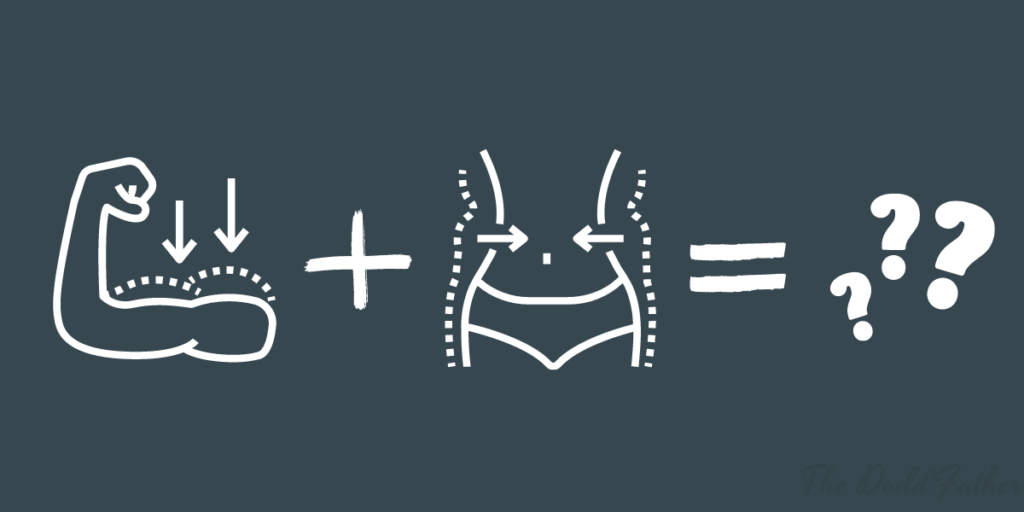
Understanding Calorie Deficits and Muscle Growth
Okay, let’s dive into this calorie deficit thing and see how it plays with our muscle-building goals. I’ll be honest, it can get a little confusing, but once you grasp the basics, it’s not so bad.
Definition of a calorie deficit
So, first things first, what is a calorie deficit? It’s simply when you’re consuming fewer calories than your body burns each day.
Think of it like spending less money than you earn – you’re dipping into your savings, or in this case, your body fat. We create this deficit to lose weight, and that’s where things get a bit tricky when we’re also trying to build muscle.
How muscle growth typically occurs
See, typically, muscle growth happens when we’re in a calorie surplus. That’s when we’re eating more calories than we burn, giving our bodies the extra fuel it needs to build new muscle tissue. It’s like investing in a construction project – you need those extra materials to build something new.
The apparent contradiction between muscle growth and calorie deficits
Now, here’s the apparent contradiction: how can we build muscle when we’re in a deficit, essentially telling our bodies to conserve energy? It seems like we’re trying to have our cake and eat it too, right? Well, it’s not impossible, but it definitely requires some finesse.
I remember when I first started trying to build muscle while cutting. I was so confused! I’d be hitting the gym hard, eating clean, but the scale wasn’t budging, and I wasn’t seeing much muscle growth either. I felt like I was doing everything right, but something was off.
It took me a while to realize that I was being too aggressive with my calorie deficit. I was cutting back so much that my body was going into survival mode, holding onto every ounce of fat it could and sacrificing muscle growth in the process. It was a frustrating lesson to learn, but it taught me the importance of finding the right balance.
The truth is, building muscle in a calorie deficit is possible, but it’s a slower process, and it requires careful planning. You need to make sure you’re getting enough protein to support muscle growth, lifting heavy weights to stimulate those muscles, and getting enough rest to allow your body to recover. It’s a delicate dance, but it can be done.
From September 1st to December 1st, I dramatically changed my body composition by continuing to push progressive overload while in a manageable caloric deficit. So you tell me, did it work?
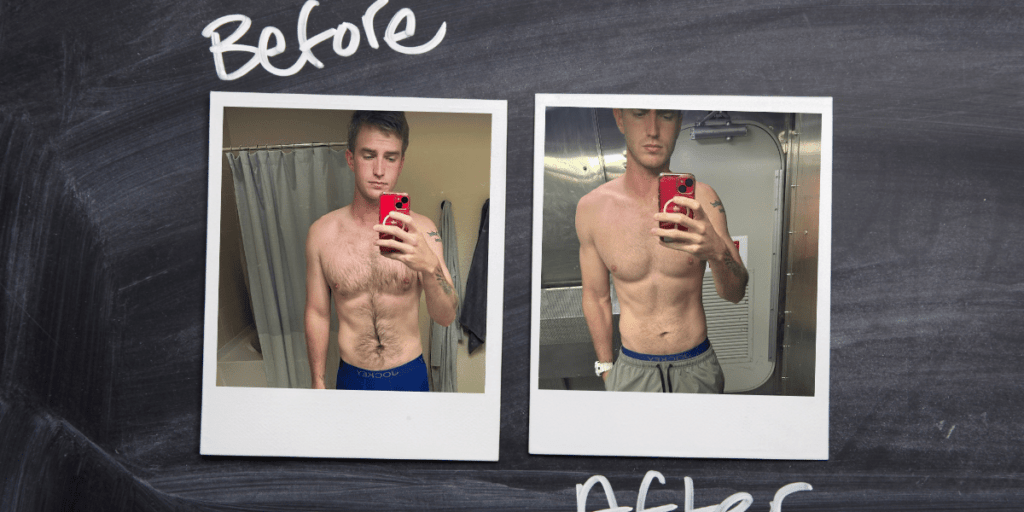
The Science Behind Body Recomposition
Alright, let’s dive into the fascinating world of body recomposition. It’s like the holy grail of fitness goals – losing fat and gaining muscle simultaneously. It sounds almost too good to be true, right? But it’s absolutely possible, and understanding the science behind it can help you achieve it.
Essentially, body recomposition is all about shifting your body’s composition. You’re decreasing your fat mass while increasing your lean muscle mass. It’s not just about the number on the scale, but about how your body looks and feels.
Remember those times when you were working out consistently, and although the scale didn’t move much, your clothes fit better and you felt stronger? That, my friends, was likely body recomposition in action.
Hormonal Factors Influencing Mucle Growth and Fat Loss
Now, let’s talk hormones. They play a HUGE role in this process.
Testosterone, for example, is key for muscle growth. It helps your body utilize protein to build and repair muscle tissue.
Growth hormone also plays a part, stimulating both muscle growth and fat breakdown.
So, keeping these hormones balanced is essential for successful body recomposition.
Role of Protein Synthesis in Muscle Building
Another crucial factor is protein synthesis. This is the process where your body uses protein to build new muscle proteins.
When you work out, you create tiny tears in your muscle fibers. Protein synthesis helps repair these tears, making your muscles bigger and stronger. So, make sure you’re getting enough protein in your diet, especially after your workouts.
Body recomposition isn’t magic; it’s science. It takes dedication, consistency, and a good understanding of how your body works. But trust me, when you start seeing those changes in the mirror and feeling the difference in your strength and energy levels, it’s all worth it.
Factors That Influence Muscle Growth in a Calorie Deficit
Alright, so you’re in a calorie deficit, aiming to shed some fat, but you also want to hang onto those hard-earned muscles, or maybe even add a little size.
Can you build muscle in a calorie deficit? It’s a tricky balance, but it’s definitely doable.
A few things play a major role in whether you’ll see muscle growth while cutting, and understanding them can make a huge difference in your results.
Training experience and its impact
First off, let’s talk about your training experience. If you’re a newbie to the gym, chances are you’ll see some muscle growth even in a deficit. This is because your body is super responsive to new stimuli.
I remember when I first started lifting, I was gaining muscle and losing fat at the same time, even though I wasn’t tracking my calories very closely.
But as you become more experienced, it gets tougher. Your body adapts, and muscle growth slows down. That’s when you need to focus on progressive overload, making sure you’re constantly challenging your muscles with heavier weights or more reps.
Genetics and individual variations
Now, let’s not forget about good ol’ genetics. Some people are just genetically predisposed to build muscle more easily than others. It’s frustrating, but it’s the truth.
I’ve got a buddy who can barely look at a dumbbell and he gains muscle, while I have to bust my butt in the gym to see any progress. But don’t let that discourage you. Even if you’re not genetically blessed, you can still make significant gains with hard work and dedication.
Current body composition and its effect on muscle-building potential
Your current body composition also plays a role. If you’re already pretty lean, it’s going to be harder to build muscle in a deficit. This is because your body is already under stress from the calorie restriction, and it may prioritize preserving energy over building new muscle tissue.
On the other hand, if you have a bit more body fat to lose, you may have a bit more wiggle room for muscle growth.
So, can you build muscle in a calorie deficit? The bottom line is, building muscle in a calorie deficit is possible, but it’s not easy.
It requires a combination of smart training, proper nutrition, and a bit of patience. Don’t get discouraged if you don’t see results overnight. Just keep at it, and you’ll eventually reach your goals.
Nutrition Strategies for Building Muscle in a Calorie Deficit
Alright, let’s dive into the nitty-gritty of eating to gain muscle while also cutting down on fat. It sounds like a contradiction, doesn’t it? “Eat less, but build more?” It’s totally possible, but you gotta be smart about it.
Importance of high protein intake
First and foremost, protein is your best friend. I mean, it’s basically the building blocks of muscle, right? So, you gotta make sure you’re getting enough of it.
I remember back in the day, I was trying to get ripped, but I wasn’t eating enough protein. I was hitting the gym hard, but my muscles just weren’t growing. It was frustrating as heck. Finally, a trainer at my gym set me straight. He told me to up my protein intake, and boy, did that make a difference!
Shoot for at least 1 gram of protein per pound of bodyweight. If you weigh 150 pounds, aim for 150 grams of protein a day. That might sound like a lot, but it’s doable.
Spread it out throughout the day, and make sure you’re getting protein with every meal. Good sources include chicken, fish, beef, eggs, Greek yogurt, and protein powder.
Optimal macronutrient ratios
Next, let’s talk about macronutrient ratios. This is where things can get a little tricky.
You need to find the right balance of protein, carbs, and fats to support muscle growth while still being in a calorie deficit.
There’s no one-size-fits-all answer here, as it depends on your individual needs and goals.
A good starting point is something like 40% protein, 30% carbs, and 30% fats. But don’t be afraid to experiment and see what works best for you.
Track your progress, and adjust your macros as needed. Remember, it’s a journey, not a destination.
Timing of nutrient intake for muscle growth
Finally, let’s talk about timing. When you eat can be just as important as what you eat. To maximize muscle growth, it’s important to get protein and carbs around your workouts.
Have a protein-rich meal or snack an hour or two before you hit the gym, and then another one within an hour or so after your workout. This will help your muscles recover and rebuild.
Also, don’t skip breakfast! It’s the most important meal of the day, especially when you’re trying to build muscle. A good breakfast will give you the energy you need to power through your workouts and your day.
Building muscle in a calorie deficit takes planning and discipline, but it’s definitely achievable. Focus on getting enough protein, find the right macronutrient ratio for you, and time your nutrient intake strategically.
And most importantly, be patient and consistent. Rome wasn’t built in a day, and neither are muscles!
Workout Techniques to Maximize Muscle Growth While Cutting
So, you’re trying to walk that tightrope – shredding fat while maintaining, or even building, muscle. It’s a balancing act, no doubt, but it’s absolutely possible with the right workout techniques.
Now, I’m no bodybuilder, but I’ve had my share of gym sessions and learned a thing or two about optimizing workouts during a cut.
Progressive overload principles
First things first, let’s talk about progressive overload. It’s the golden rule of muscle growth, whether you’re cutting or bulking.
Basically, it means gradually increasing the demands on your muscles over time. This could mean adding more weight, doing more reps, or decreasing rest periods.
The key is to keep challenging your body so it has no choice but to adapt and grow.
I remember when I first started lifting, I was stuck at the same weight for months. I didn’t understand the importance of tracking the weights.
But once I started focusing on progressive overload, I saw real gains. Even small increases in weight or reps can make a big difference over time.
Importance of compound exercises
Next up, compound exercises. These are the big hitters, the ones that work multiple muscle groups at once.
Think squats, deadlifts, bench presses, rows – these are your bread and butter. They’re not only efficient, but they also stimulate more muscle growth and boost your metabolism.
I used to spend hours doing isolation exercises, trying to target every little muscle. But honestly, I saw much better results when I focused on compound lifts.
They’re the foundation of any good workout program, especially when you’re cutting.
Optimal training frequency and volume
Finally, let’s talk about training frequency and volume. How often and how much you train can impact muscle growth.
During a cut, you might need to adjust your training volume slightly to account for the reduced calorie intake. But don’t go too low – you still need to provide enough stimulus for your muscles to grow.
Aim for 3-4 workouts per week, hitting each muscle group 2-3 times. And remember, quality over quantity. Focus on performing each exercise with good form and intensity.
Remember, building muscle while cutting requires consistency, dedication, and a smart workout plan. Don’t be afraid to experiment and find what works best for you.
And most importantly, listen to your body. If you’re feeling overly fatigued or sore, it might be a sign to back off a bit.
The Role of Rest and Recovery in Muscle Building
Alright, folks, let’s talk about something that often gets overlooked in the quest for gains: rest and recovery.
We all love hitting the gym, pushing ourselves to the limit, chasing that pump.
But here’s the thing – your muscles don’t grow while you’re lifting weights. They grow when you’re resting, recovering, and giving your body a chance to repair and rebuild.
Importance of sleep for muscle growth and fat loss
Now, I’ll be the first to admit, I used to be terrible at this. I’d stay up late, chugging coffee and trying to squeeze in one more workout.
I thought I was being dedicated, but in reality, I was sabotaging my own progress.
See, sleep is when your body releases growth hormone, which is essential for muscle repair and growth. It’s also when your body regulates hormones that control hunger and metabolism.
Skimp on sleep, and you’re messing with all of that.
Stress management techniques
Another key factor in recovery is stress management.
When you’re stressed, your body releases cortisol, a hormone that can break down muscle tissue and promote fat storage. It’s like the opposite of what we want!
I’ve definitely been there – deadlines piling up, family drama, you name it. And let me tell you, it shows up in the gym.
My lifts would be weaker, my energy would be low, and I’d just feel generally crappy. That’s when I realized I needed to find ways to manage my stress.
Meditation, yoga, even just taking a walk in nature – these things can make a world of difference.
Active recovery strategies
Let’s talk about active recovery. This doesn’t mean hitting the gym for another intense workout. It means doing something light and gentle that promotes blood flow and helps your muscles recover.
Think leisurely walks, light stretching, or even a relaxing swim. I used to think rest days meant lying on the couch all day, but then I discovered the magic of active recovery.
It helps reduce muscle soreness, improves flexibility, and gets you back in the gym feeling refreshed and ready to go.
Rest and recovery aren’t just important – they’re essential for making progress in the gym.
If you’re serious about building muscle and achieving your fitness goals, make sure you’re giving your body the downtime it needs. Trust me, you’ll be glad you did.
Supplements That May Aid Muscle Growth in a Calorie Deficit
Let’s face it, building muscle when you’re cutting calories is no walk in the park.
It’s like trying to build a house while on a strict budget – you need to be smart about where you invest your resources.
Supplements can be a helpful tool, but they’re not magic bullets.
They work best when combined with a solid training plan and a well-structured diet.
Protein powders and their benefits
Protein powders are a staple for many fitness enthusiasts, and for good reason. They’re a convenient way to boost your protein intake, which is crucial for muscle repair and growth.
I remember when I first started using protein powder, I was skeptical. I thought it was just a gimmick. But after a few weeks, I noticed a difference in my recovery and muscle definition.
Now, I make sure to have a protein shake after every workout.
Whey protein is a popular choice because the body quickly absorbs it, but there are also plant-based options like pea protein and hemp protein.
Creatine supplementation
Creatine is another supplement that has been extensively studied and proven to be effective for increasing muscle mass and strength.
It works by increasing the availability of phosphocreatine in your muscles, which provides energy for short, intense bursts of activity.
I’ve used creatine on and off over the years, and I’ve always noticed a boost in my performance in the gym. It’s especially helpful when I’m lifting heavy weights or doing high-intensity interval training.
Other potentially helpful supplements
There are a few other supplements that may be beneficial for muscle growth in a calorie deficit, although the evidence is less conclusive.
- Beta-alanine, for example, has been shown to improve exercise performance and delay muscle fatigue.
- Branched-chain amino acids (BCAAs) may also help reduce muscle breakdown and promote muscle protein synthesis.
- And let’s not forget about good old-fashioned fish oil, which has numerous health benefits, including reducing inflammation and improving insulin sensitivity.
Remember, supplements are just that – supplements. They can’t replace a healthy diet and a consistent training program.
But if you’re looking for an extra edge in your quest for muscle growth in a calorie deficit, they can be a valuable addition to your arsenal.
Just do your research, choose high-quality products, and use them responsibly. And as always, consult with a healthcare professional before starting any new supplement regimen.
Realistic Expectations and Timeframes
Let’s be real for a second. We all want to see results fast. Whether it’s dropping a pant size or packing on some serious muscle, we want it yesterday.
But here’s the thing: real, lasting change takes time. It’s about setting achievable goals, understanding the natural pace of your body, and having the patience to stick with it.
Setting achievable goals
I remember when I first started my fitness journey, I was so gung-ho. I wanted to lose 20 pounds in a month, and I was convinced I could do it.
But guess what? It didn’t happen. And that’s okay. It’s important to set goals that are challenging but also realistic.
If you’re aiming for something that’s way out of reach, you’re setting yourself up for disappointment. Start small, celebrate your wins, and gradually increase your goals as you progress.
Understanding the rate of muscle gain vs. fat loss
Another thing to keep in mind is that muscle gain and fat loss happen at different rates. You can’t expect to build a ton of muscle while also shedding a significant amount of fat.
It’s like trying to drive a car forward and backward at the same time – it just doesn’t work. Be patient with the process, and focus on one goal at a time.
Importance of consistency and patience
The key to success is consistency and patience. There will be days when you don’t feel like working out, or when you’re tempted to indulge in unhealthy foods.
But it’s important to stay the course. Remember, it’s about progress, not perfection. Every small step you take is moving you closer to your goal.
So don’t give up, even when it gets tough. Trust the process, and you’ll eventually see the results you’re looking for.
And one more thing: don’t compare yourself to others. Everyone’s journey is different.
What works for one person may not work for another. Focus on your own progress, and celebrate your own victories, no matter how small they may seem.
It’s not about being the best; it’s about being your best.
Conclusion
Hopefully by now you have your answer to “Can you build muscle in a calorie deficit?”.
Building muscle in a calorie deficit isn’t just a myth – it’s a real possibility for many individuals, especially those new to resistance training or returning after a break.
While it may be challenging, with the right combination of nutrition, training, and recovery strategies, you can achieve the holy grail of fitness: gaining muscle while losing fat.
Remember, everyone’s journey is unique, so be patient with your progress and celebrate every victory along the way.
Ready to transform your body? It’s time to hit the gym and put these strategies into action!
